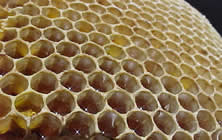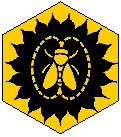Queen Introduction
Queen introduction is very important after putting so much work into the queens
Different cages are used for different circumstances but push in cages give the most reliable introduction, about 95% successful.
 A queen has a much better chance of being accepted if she is laying eggs
A queen has a much better chance of being accepted if she is laying eggs
Inseminated queens stay under the cage for a week, and then released by hand.
A different push in cage with a candy tube is used if you can’t come back to release the queen by hand.
Standard 3 hole candy cages are used for shipping. But push in cages are sent along with queens and recommended for the best introduction.
Once they have started laying inseminated queens generally perform as well as naturally mated queens. Detailed instructions for introducing queens
Evaluating Performance
 Since our top breeding priority is mite resistance, all of our test colonies go untreated.
Colonies of all different types are compared in each yard.
Mite counts are done twice a year in Jan and July for tracheal and varroa mites
100 bees are collected in a vial of alcohol for later testing. Varroa mites are washed off and counted. 10 bees are dissected to detect tracheal mites.
Evaluation is done for honey production, brood production and gentleness
The best colonies are selected to produce the next generation of drones and queens.
Since our top breeding priority is mite resistance, all of our test colonies go untreated.
Colonies of all different types are compared in each yard.
Mite counts are done twice a year in Jan and July for tracheal and varroa mites
100 bees are collected in a vial of alcohol for later testing. Varroa mites are washed off and counted. 10 bees are dissected to detect tracheal mites.
Evaluation is done for honey production, brood production and gentleness
The best colonies are selected to produce the next generation of drones and queens.
The question everyone wants to know is which type of bee produces the most  honey.
I wish there was an easy answer, but there seems to be as much variation between colonies of the same race as there is between races. Every year there are outstanding colonies of each type. I’ve come to the conclusion that the most important factor is the combinations of subfamilies in each hive and how well they work together. So just as with people, it’s probably not helpful to generalize by race, but to consider each colony on it’s own merits.
honey.
I wish there was an easy answer, but there seems to be as much variation between colonies of the same race as there is between races. Every year there are outstanding colonies of each type. I’ve come to the conclusion that the most important factor is the combinations of subfamilies in each hive and how well they work together. So just as with people, it’s probably not helpful to generalize by race, but to consider each colony on it’s own merits.
Before you all take out your calculators and conclude this might be an easy way to  get rich quick, let’s take a look at some hard facts of life. In any complex natural system there are lots of opportunities for losses to occur. Before a queen produced this way is ready for her final destination, she has already passed through 4 different colonies. At each step there are risks of damage to the young queen. One might expect that the biggest problem might be drone layer queens, if the insemination doesn’t go right. But here you can see, that there are lots of ways to lose queens, but drone layers or poor layers only account for less than 2%. Introduction losses are not too bad only about 5 percent. Early losses can mean anything from ants or wasps attacking a nuc, to supercedure. The bank loses here are somewhat inflated because they include the several hundred queens I try to overwinter. I know I’ll probably lose many of these queens, but it’s still worth it to have some queens for my own use in Jan and Feb. before I can raise new ones.
get rich quick, let’s take a look at some hard facts of life. In any complex natural system there are lots of opportunities for losses to occur. Before a queen produced this way is ready for her final destination, she has already passed through 4 different colonies. At each step there are risks of damage to the young queen. One might expect that the biggest problem might be drone layer queens, if the insemination doesn’t go right. But here you can see, that there are lots of ways to lose queens, but drone layers or poor layers only account for less than 2%. Introduction losses are not too bad only about 5 percent. Early losses can mean anything from ants or wasps attacking a nuc, to supercedure. The bank loses here are somewhat inflated because they include the several hundred queens I try to overwinter. I know I’ll probably lose many of these queens, but it’s still worth it to have some queens for my own use in Jan and Feb. before I can raise new ones.
All in all only 40% of the queens are sold, and another 20% used for our own test colonies.
I show you this chart not because I’m especially proud of my record, clearly there’s room for improvement. But it may help you to know what kind of challenges to expect when you start producing inseminated queens. Perhaps the the hardest lesson of all is to be able to accept the inevitable losses as the cost of doing business, without becoming discouraged.
Taking Care of Business
Raising the bees is one thing, getting them to those who need them is a another matter.
That’s where Suki shines. She knows as much about bees as I do and has kept bees since before we met. So together we make a good team.
Shipping bees is a tricky business. Attention to details makes all the difference between a happy customer and an expensive fiasco. Everything from making the queen cage candy with the right consistency, to using the right shipping box for the weather conditions is important. By using UPS overnight delivery, very few queens are lost or damaged in shipment.
 Suki does a great job of keeping the business end running smoothly, which is at least as important as producing the queens.
Suki does a great job of keeping the business end running smoothly, which is at least as important as producing the queens.
As I said before, bee breeding is a very cooperative affair. The more members in the breeding network, the more interesting and productive the work. New technologies and scientific discoveries promise to create an even greater demand for controlled mating of bees in the future. With honeybees right at the cutting edge of the biological revolution, interesting opportunities certainly await those who take up the task
From a talk presented by Tom Glenn at Apimondia in Melbourne Australia, Sept. 2007

About Us | Site Map | |
This page is no longer being updated.
 Glenn Apiaries
Glenn Apiaries